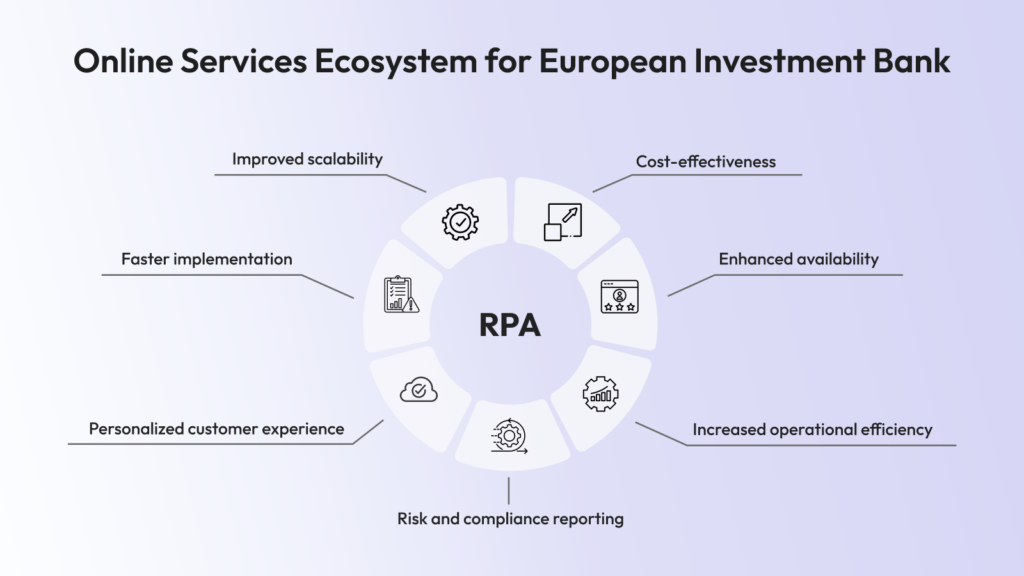Banks are being pushed all the time to achieve more with less, which includes lower costs, stricter compliance, quicker service, and fewer errors. It can be assisted by Robotic Process Automation (RPA). By replicating the actions of a human on a computer, RPA bots have the potential to automate time-intensive repetitive tasks, which allows employees to focus on other, more valuable tasks. RPA in banking is already fully transforming bank operations, which is why it is no longer a concept of the future.
What Is RPA in Banking?
In robotic process automation, software bots are employed to perform rule-based activities in numerous applications. A bot is a highly productive online worker. It works 24 hours a day and is 100% accurate without taking breaks.
With these bots, all areas of banking are under control, such as the detection of fraud, regulatory reporting, processing of loans, and onboarding of customers.
Why Banks Are Turning to RPA
Banking is one such industry that is heavily reliant on processes. Many of these are routine, repetitive, time-consuming processes, the best place to automate.
That is why RPA is becoming popular in banking:
- Speed: a human being can work on a certain task in 10 minutes, a bot can do this task quickly in several seconds.
- Precision: Bots do not make typing errors or forget to carry the one.
- Compliance: Automated audit trails and logs make compliance easier.
- Cost Savings: This helps to save costs by automating routine tasks that do not require large teams of back-office employees.
- Scalability: Requirement to 10x the amount of transactions during tax season. Just spin up more bots.

Real-World Use Cases of RPA in Banking
Now, let’s explore the areas where RPA in banking is having the greatest effect.
Customer Onboarding
Opening a new account involves obtaining documentation, checking identity, doing background checks, and completing multiple systems. This may take hours when it is done manually and often annoys clients.
RPA is applied in banks to automate data entry into systems, conduct background checks, and verify IDs. The result is a reduction in onboarding time, which can take from days to minutes.
A European bank deployed RPA and decreased the time spent processing by 80 percent when onboarding new clients. It reduced operating costs while simultaneously increasing customer satisfaction.
Loan Processing
The lending process goes through several stages, which are as follows: collecting documentation, risk analysis, credit rating, and data entry into a system. Several verification layers and departmental integration are required for this.
An RPA bot has the capacity to scan documents, extract relevant information, to verify information, and transfer it to the core system of the bank without human intervention. Applications that are to be manually reviewed are only flagged.
One American bank was capable of verifying loan data using a bot in less than ten minutes, on average, compared to more than forty-five minutes previously.
KYC and AML Compliance
Anti-Money Laundering and Know Your Customer checks are mandatory, but they can be time-consuming. They involve compiling, analyzing, and recording information.
RPA can gather both internal and external client data, verify red flags or blacklists, and maintain detailed audit records.
To illustrate, a multinational bank automated its KYC renewal process with RPA. The bots extracted data in more than fifteen internal systems and performed automated validations. The resultant saving by the bank was over 30,000 hours per year.
Regulatory Reporting
Regulators also compel banks to prepare reports for them on a periodic basis. The extraction of data, the formatting of the data in accordance with the strict templates, and data integrity are all steps of the process.
The implication is that bots find information within systems in real-time, search it to identify anomalies, and generate reports that are readable to submit, instead of spreadsheets and human work, which is essential if your plan is to make ERP software or implement RPA withinan existing one
A mid-sized Asian bank automated regulatory submissions with RP, saving it 70% of the time on reporting. Audit work was made more effective, and the number of errors was reduced significantly.
Card Dispute Resolution
Disputes related to illegal transactions, failed payments, and invoicing issues should be resolved promptly.
Conventionally, this involves inspecting card network data, transaction history, and client history, often spanning multiple systems.
Bots are capable of handling the entire process, i.e., detecting the disputed transaction, comparing it against the rules, initiating the resolution process, and notifying the customer. This enhances the credibility of clients and reduces the time to resolve.
How RPA in Banking Works
Just as human beings physically engage with user interfaces and open applications, click buttons, copy and paste information, and execute responses, RPA bots also do so. Yet behind the scenes, they are guided by some well-established rules and triggers.
The majority of bots have been divided into two categories:
- Attended bots: Cooperate with humans, performing part of the task.
- Unattended bots: Operate on their own on scheduled tasks, such as batch processing.
- In order to use RPA, banks tend to go through the following route:
- Selection of Process: Select high volume, repetitive process that is rule based.
- Workflow Design: Chart out all actions the bot is going to make.
- Bot Development: Utilize such tools as UiPath, Automation Anywhere, or Blue Prism.
- Testing and Deployment: Deploy bots in a sandbox and make sure it works.
- Monitoring and Maintenance: Track performance and make corrections where necessary.
Challenges Banks Should Should Look Our For
Although RPA has obvious advantages, it does not have a plug-and-play nature.
- Complexity of processes: RPA is most effective on regular, routine processes. Bots can easily break in case your process evolves often.
- Data Quality: Bad data in = bad results. Bots are dependent on well structured data.
- Security Risks: Access to sensitive systems should be airtight,t given the access of bots to those systems.
- Change Management: The fear of automation is a possibility among employees. Banks require effective communication and upskilling services.
How RPA Complements AI
RPA is not artificial intelligence, yet the two may be used in tandem.
Suppose you have inflows of customer emails 24/7. AI may read through the content, discover the purpose, and classify it. Then RPA comes into play- activating the correct workflow, filling forms, and responding.
This type of hybrid, AI + RPA, is commonly referred to as Intelligent Automation. It is a combination of decision-making and task execution that opens up the use cases to more complex uses.




